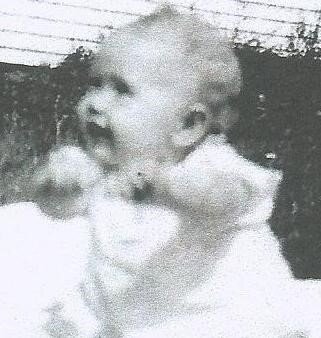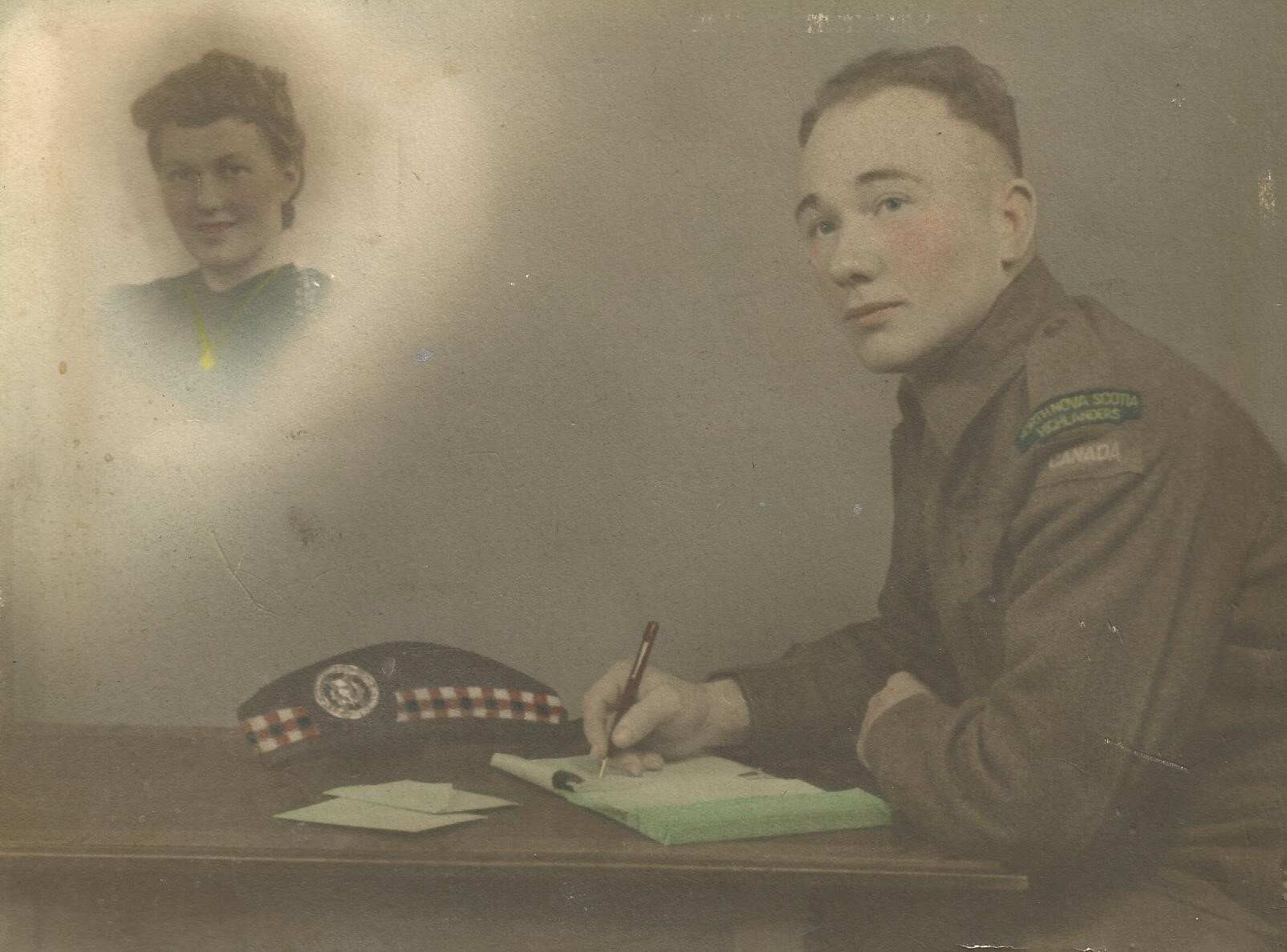Sergeant Edison Alexander Smith
Information provided by Harriet Jenereaux, daughter of Sergeant Smith.
Edison Alexander was born on October 7, 1912 at West Point, Prince County, Prince Edward Island, Canada.
He was eight years older than his future wife, Helen, and got to know her when he dated her sister. He lived two miles from them and had to walk to the court. He teased her and said. “Don’t you worry, Helen, I’m going to wait until you finish growing up and marry you.” She was fourteen at the time so she didn’t take him seriously. But he was a man of his word, and started dating her when she was about eighteen and won her heart.
Shortly after her twentieth birthday, they were married on April 10, 1940.
They didn’t have long to enjoy married life because Germany had begun to invade countries in Europe on September 1, 1939 with the invasion of Poland. Britain and France declared war on Germany eight days later and Canada did the same ten days after that.
The war in Europe touched Edison’s sense of patriotism and, from his military records, it is noted that on July 2, 1940 he took the oath of service in Charlottetown. Due to his love of the sea, he had it in his heart to join the navy but was directed into the North Nova Scotia Highlanders. He took his training in Amherst, Nova Scotia from July 3, 1940- May 18, 1941, at which point he was reported to Debert, Nova Scotia.
Both Edison and his oldest brother, Nelson, were North Novas when they signed up, but Nelson was transferred to the West Novas. It was a relief to Edison, as he had worried about them being together in the same battle. However, his brother- in-law, Ralph Schurman Boulter, was added to the company but a different platoon, both died in the same battle.
Edison’s medical records noted that he was 5ft. 6in tall and weighed 138lbs. He had a medium complexion and grey eyes with brown hair. He was not a big man but everything about him showed him to be a normal twenty-seven year old. He was rated as superior and he gave his reasons for joining as, “to help with the war.” The desire to be a helper went with him all the way to his death.
He had become a father on July 20, 1940 when Helen delivered Douglas Scott, while Edison was in Basic training. Douglas was the pride of his life, even though they only have a few short times spent together. He got to enjoy him, with his family at West Point, when he had his furlough from Dec. 7-20, 1940. Helen and Douglas joined him in Nova Scotia as soon as she could.
He was a Batman while he served in Debert. Helen and Douglas joined him as he waited for his orders to go overseas. The orders arrived and he embarked to Halifax, Nova Scotia on July 18, 1941. They set sail for Europe on July 20, 1941, on Douglas’ first birthday. He left a pregnant Helen and year old Douglas still in her arms. She returned to Prince Edward Island and lived with his parents for the next thirteen years. He disembarked at Avonmouth, UK, July 31, 1941.
On December 21, 1941, Helen delivered Harriet, a baby girl of over 11 pounds. Most pictures of Harriet and Douglas in those years went to Europe and, because none of his private things ever came home, they are lost.
Edison was wounded on July 25, 1944. He was treated for a fractured right femur.
He had been slated to receive his L/Cpl but was reverted to Pte. when wounded. He returned to duty in France on Aug. 25, 1944.
Edison was listed as A/Cpl after Sept. 25, 1944 and, as of Oct. 6, 1944, he had the rank of Corporal. On Feb. 19, 1945, he was promoted to A/Sgt. and was addressed as Sergeant from that time util the time of his death on March 25, 1945, during the battle for the Rhine at Bienen, Germany. He died on the top of the dyke. Edison’s death is recorded in at least two non-fiction volumes.
Quoting from No Retreating Footsteps, the story of the North Novas by Will R. Bird, published by Furlong’s Rapid print & Digital Design, Amherst, Nova Scotia. These quotes are from the chapter Over the Rhine.
Page 347 records, “Sgt. Edison Smith was Lt. Monkley’s mainstay until he was killed.”
Page 345, “Sgt. E. A. Smith of Seventeen Platoon, seeing the many casualties and noting the enemy fire positions, dashed back over the dyke through a hail of fire, contacted the tanks and told them of the situation, then rejoined the platoon and began helping remove some of the seriously wounded. Soon he, too, fell wounded, but kept on doing great work until he was killed.”
Quoting from TOO YOUNG TO DIE by John Boileau and Dan Black, James Lorimer & Company Ltd., Publishers, Toronto; “While Maj. Dickson was lying wounded on the dike, men stopped to help, but he told them to keep going. Then, a mortar blast sent Sergeant Edison Smith of West Point, Prince Edward Island, into the air. The sergeant’s body landed on Dickson before rolling off the side of the dike, but it protected the major from the mortar blast.”
When Harriet read about his death, she said to Douglas, “If he hadn’t been such a hero, he might have made it home.”
Major Dickson always said that Edison saved his life and always visited his grave when he visited Holland and Germany. He became not only a judge back home in New Brunswick, but an historian who became friends with a German historian, Josef Becker. He showed Josef the very spot where the incident occurred, and he also showed Harriet.
It was indeed special to Harriet to know the very spot his life blood flowed and that in dying he saved a life. She didn’t know that until we visited Holland.
Edison was first buried in Germany’s Bedburg No.1 Temporary Canadian Military Cemetery. Then, on Jan.28, 1947, the grateful people of Holland reburied all the Canadian servicemen who had died in that battle that liberated them at Nijmegen Canadian Military Cemetery, Grave 13, Row H, Plot 5. Groesbeek, Netherlands, where he lies today with his grave lovingly cared for by the children of people he sought to liberate. They have so many ceremonies every year to make sure nobody will ever forget their sacrifice. Edison’s family was able to witness three of such ceremonies.
Major Dickson at Edison’s grave
Edison’s original grave marker cross
Today, the graveyards have been beautified and every slain member of the Armed Forces has a beautiful monument, which replaced the cross that marked his/her resting place. Different graves are given to different families to tend. They lovingly keep flowers on them. 2020 was the 75th anniversary of their liberation and they put tulips on every grave. They also put candles on them at Christmas, and are working to put a face to every grave. Harriet had the privilege to place both Edison’s and her Uncle Ralph’s pictures on theirs. They have a perfect place to rest in peace.
In 1966, she met a Mr. Arsenault, who had served with Edison. He said he told his war-bride wife that he had met the daughter of Sgt. Smith. He told me that in order for her to remember him he described Edison as “the one that sat in the corner writing to his wife.” That could be why he sent this picture to Helen.
“ALL GAVE SOME, SOME GAVE ALL”
This quote is attributed to Korean War veteran
Howard William Osterkamp
~~~~~~~~~~~~~~~~~~~~~~~













